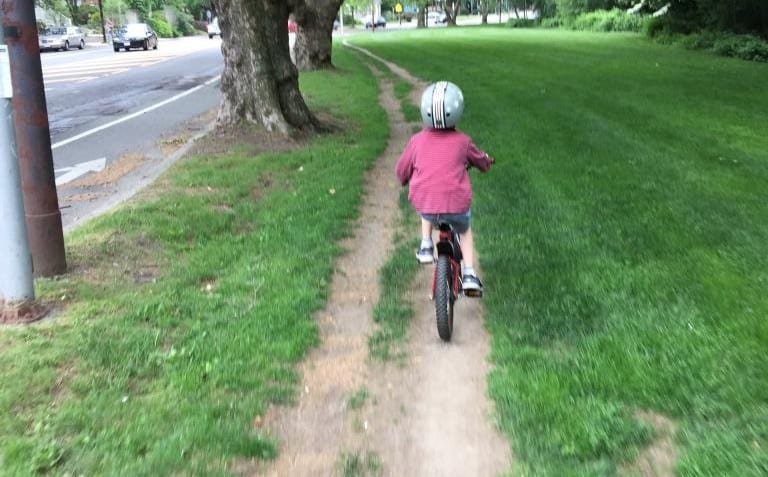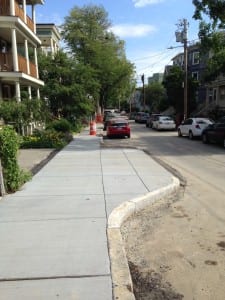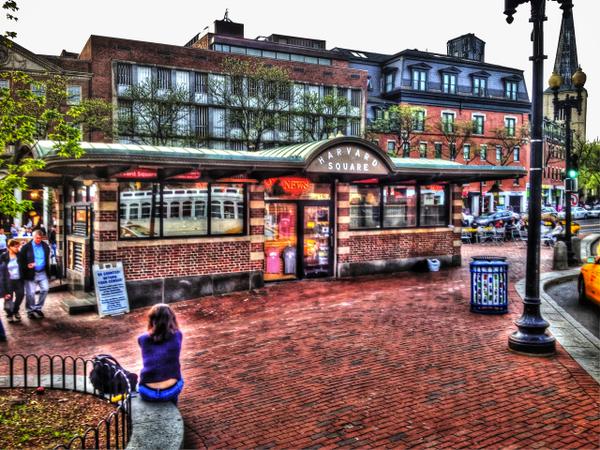This week I spent quite a bit of time thinking about sidewalk design, street plantings, and “placemaking.” Sidewalks are not a new preoccupation. The lack of sidewalks along New Street was one of the first issues I got involved with as president of the Fresh Pond Residents Alliance, and I’m proud to say that our group’s lobbying brought about the city’s decision to completely reconstruct New Street, starting this summer. At Monday’s Council hearing artist and Market Street resident Florrie Westcoat spoke in support of Area 4 beautification projects like the small planting area in a sidewalk bump-out on her street. She said many people stop to thank her when they see her tending and watering the plants. She feels this small urban garden is building community and neighborhood pride and hopes the city will create more little planting areas in Area 4 (not surprisingly flowers have the opposite of “broken windows effect”).
In my West Cambridge neighborhood the sewer separation project has provided a crash course in sidewalk design. However, despite their best efforts to do their homework, some residents of Chilton Street were blindsided this week by the decision to eliminate grass strips in front of their homes and to create wider sidewalks and bump-outs with no planting areas. Chilton Street is a narrow one-way street where bump-outs are unnecessary as a safety or traffic calming feature; the decision to preference concrete over grass seems in conflict with the project’s overarching goal to better manage storm water runoff. Communication with residents broke down at some point during the three-year design process, and unfortunately DPW prioritized the wishes of a one vocal group, who did not wish to maintain grass strips, over the public benefit of having more green. Residents noticed the change only as the new sidewalks were being poured. Given the complexity of this multi-year project, DPW and the contractors might consider opening a customer service center in the neighborhood to improve communication and responsiveness to resident and business owners. A project of this scope needs a familiar and knowledgeable staff member on site to whom we can direct questions and concerns as they arise, face-to-face.
Meanwhile, there are no sidewalks at all on the north side of busy Huron Avenue between Fresh Pond Parkway and the municipal golf course. People, including many families with children, wishing to walk west from Huron Village to the Haggerty School, Glacken Field and playground, and the West Cambridge Youth Center have worn a dirt path into the grass. Doug Brown, my campaign treasurer and a Haggerty parent, has been lobbying for sidewalks and a protected bike lane, and the result is a policy order sponsored by Councillor Nadeem Mazen on this week’s Council agenda. A large part of a councillor’s job is listening and proactively responding to constituents’ concerns and suggestions – the only surprise is that it took so long for anyone to notice the obvious opportunity to improve safety and accessibility alongside a major street.
Opportunities to improve sidewalk design and landscaping cropped up again on Tuesday night during an FPRA meeting I organized to provide the new owner of the Tokyo restaurant and his architect a chance to present plans for the redevelopment of the property into an extension of the auto repair garage next door. This long derelict property occupies a very prominent location that is the gateway to our residential neighborhood from Fresh Pond. Residents asked the owner to leave adequate space for planting beds and possibly a fence to screen the parking lot from passersby on Vassal Lane. Everyone expressed frustration with how the sidewalk along Vassal connects to the DCR portion of the sidewalk through the grassy area at the parkway crosswalk — an increasing number of cyclists use the sidewalk and are often in conflict with pedestrians and dog walkers. All of this activity takes place just a few feet from the building’s front facade. The grassy area between the crosswalk and the Tokyo building cries out for a thoughtful redesign and regular maintenance. Our goal is to work with the owner, the city and the state (DCR) to ensure that it presents an attractive face and to improve the safety and functionality of the connection between the pond, the neighborhood and the Tobin School.
On Thursday evening I attended a continuation of the Harvard Square “placemaking” discussion, which focused on the future renovation and repurposing of the city-owned Out of Town News building from a newsstand into some type of public space. It’s only 500 s.f. and there’s no water or sewer service, so it seems likely to become exhibit space rather than a cafe. Before the meeting I sat at a table under the trees in Forbes Plaza in front of the Smith Campus Center (formerly known as Holyoke Center) and thought about Harvard’s proposal to enclose a quarter of the plaza with a two-story glass addition that would serve as a larger welcome center for visitors. In a letter to the BZA, which will hear Harvard’s request for a variance on June 25, I called this plan more like “placetaking” than “placemaking.” Forbes Plaza could do with a facelift but doesn’t need an amputation.
A highlight of my week was Saturday’s Northpoint “Hidden Gem” walk, organized by the city’s pedestrian committee. The success of this new neighborhood depends, in large part, on connecting it (preferably by modes other than auto) to the rest of Cambridge (across O’Brien Highway, which is to be landscaped into a more pedestrian-friendly boulevard), to Somerville and Medford (via the Green Line extension), to the North End and Charlestown (via the North Bank foot Bridge underneath the Zakim Bridge to Paul Revere Park or across the Gilmore Bridge to the Orange Line). The approved master plan for this 45-acre site includes 11 acres of parkland and 5.25 million square feet of development (45% commercial and 55% residential). Ultimately there may be as many as 6,000 people living and/or working in Northpoint. One hopes car ownership will continue to decrease and that these buildings can be constructed with many fewer parking spaces than the 4,000 or so planned.




No Comments